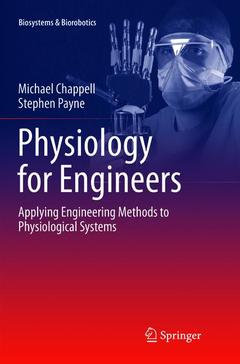Physiology for Engineers, 2016 Applying Engineering Methods to Physiological Systems Biosystems & Biorobotics Series, Vol. 13
Auteurs : Chappell Michael, Payne Stephen

This book provides an introduction to qualitative and quantitative aspects of human physiology. It looks at biological and physiological processes and phenomena, including a selection of mathematical models, showing how physiological problems can be mathematically formulated and studied. It also illustrates how a wide range of engineering and physics topics, including electronics, fluid dynamics, solid mechanics and control theory can be used to describe and understand physiological processes and systems. Throughout the text there are introductions to measuring and quantifying physiological processes using both signal and imaging technologies. Physiology for Engineers describes the basic structure and models of cellular systems, the structure and function of the cardiovascular system, the electrical and mechanical activity of the heart and provides an overview of the structure and function of the respiratory and nervous systems. It also includes an introduction to the basic concepts and applications of reaction kinetics, pharmacokinetic modelling and tracer kinetics. It is of interest to final year biomedical engineering undergraduates and graduate students alike, as well as to practising engineers new to the fields of bioengineering or medical physics.
biomedical engineering was a separate option. Having spent some time modelling bubbles in the bloodstream
and using imaging to measure perfusion and pH in the brain he has found that engineering is a great
foundation for taking a quantitative view of physiology and thus contributing to medical research as a
biomedical engineer.
Dr Payne has worked in physiological modelling for over 10 years, with particular interests in blood flow in
the brain and heat treatment of cancer. Having entered the field of biomedical engineering before it was
available even as an undergraduate option course, he has seen first-hand how difficult it can be to learn about
physiology in a way that makes it amenable to mathematical treatment, such as mathematical modelling,
without good introductory guides.
Date de parution : 03-2019
Ouvrage de 167 p.
15.5x23.5 cm
Retiré de la vente
Date de parution : 12-2015
Ouvrage de 167 p.
15.5x23.5 cm
Ancienne édition
Accéder à la nouvelle édition.



